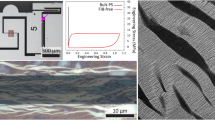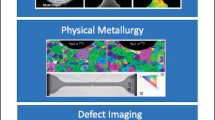Abstract
We present a new experimental method for the mechanical characterization of freestanding thin films with thickness on the order of nanometers to micrometers. The method allows, for the first time, in-situ SEM and TEM observation of materials response under uniaxial tension, with measurements of both stresses and strains under a wide variety of environmental conditions such as temperature and humidity. The materials that can be tested include metals, dielectrics, and multi-layer composites that can be deposited/grown on a silicon substrate. The method involves lithography and bulk micromachining techniques to pattern the specimen of desired geometry, release the specimen from the substrate, and co-fabricate a force sensor with the specimen. Co-fabrication provides perfect alignment and gripping. The tensile testing fits an existing TEM straining stage, and a SEM stage. We demonstrate the proposed methodology by fabricating a 200 nm thick, 23.5 μm wide, and 185 μm long freestanding sputter deposited aluminum specimen. The testing was done in-situ inside an environmental SEM chamber. The stress-strain diagram of the specimen shows a linear elastic regime up to the yield stress σ y MPa, with an elastic modulusE=74.6 GPa.
Similar content being viewed by others
References
Madou, M., Fundamentals of Microfabrication, CRC Press (1997).
Brotzen, F.R., “Mechanical Testing of Thin Films,”International Materials Reviews,39 (1),24–45 (1994).
Nix, W.D., “Mechanical Properties of Thin Films,”Metallurgical Transactions,20A,2217 (1989).
Kang, Y.S. andHo, P.S., “Thickness Dependent Mechanical Behavior of Submicron Aluminum Films,”J. Electronic Materials,26 (7),805–813 (1997).
Hoffman, R.W., “Nanomechanics of Thin Films: Emphasis: Tensile Properties,”Materials Research Society Symposium Proceedings,130,295–305 (1989).
Huang, H. andSpaepen, F., “Tensile Testing of Free-Standing Cu, Ag and Al Thin Films and Ag/Cu Multilayers,”Acta Materialia,48 (12),3261–3269 (2000).
Read, D.T., “Piezo-Actuated Microtensile Test Apparatus,”J. Testing and Evaluation,26 (3),255–259 (1998).
Yuan, B. andSharpe, W.N., “Mechanical Testing of Polysilicon Thin Films,”Experimental Mechanics,37 (1),32–35 (1997).
Greek, S., Ericson, F., Johansson, S., andSchweitz, J.A., “Micromechanical Tensile Testing,”Materials Research Society Symposium Proceedings,436,227–232 (1997).
Haque, M.A. and Saif, M.T.A., “Microscale Materials Testing Using MEMS Actuators,” to be published in Journal of Microelectromechanical Systems,10 (1) (2001).
Behr, R., Mayer, J., andArzt, E., “TEM Investigation of the Superdislocations and their Interaction with Particles in Dispersion Strengthened Intermetallics, Intermetallics,7,423–436 (1999).
Robertson, I.M., Lee, T.C., andBrinbaum, H.K., “Application of In-Situ TEM Deformation Technique to Observe how ‘Clean’ and Doped Grain Boundaries Respond to Local Stress Concentrations,”Ultramicroscopy,40,330–338 (1992).
Robert Bosch Gmbh, patents 4855017 and 4784720 (USA) and 4241045C1 (Germany).
Spaepen, F. andShull, A., “Mechanical Properties of Thin Films & Multilayers,”Current Opinion in Solid State and Materials Science,1,679–683 (1996).
Sanders, P. G., Eastman, J. A., andWeertman, J. R., “Elastic and Tensile Behavior of Nanocrystalline Copper and Palladium,”Acta Materialia,45 (10),4019–4025 (1997).
Chechenin, N. G., Botigger, J., andKrog, J. P., “Nanoindentation of Amorphous Aluminum Oxide Films III. The Influence of the Substrate on the Elastic Properties,”Thin Solid Films,304,70–77 (1997).
Vinci, R.P., Cornella, G., and Bravman, J.C., Anetastic Effects in Freestanding Al Thin Films, Proc. 5th International Workshop on Stress Induced Phenomena in Metallization, Stuttgart, Germany, 240–248 (1999).
Lee, H., Cornella, G., andBravman, J. C., “Stress Relaxation of Free-standing Aluminum Beams for Microelectromechanical Systems Applications,”Applied Physics Letters,76 (23),3415–3417 (2000).
Gibeling, J. C. andNix, W. D., “Observations of Anelastic Backflow Following Stress Reductions During Creep of Pure Metals, Acta Materialia,29,1769–1784, (1981).
Tang, W. C., Nguyen, C. H., andHowe, R.T., “Laterally Driven Polysilicon Resonant Microstructures,”Sensors and Actuators A,20,25–32 (1989).
Author information
Authors and Affiliations
Rights and permissions
About this article
Cite this article
Haque, M.A., Saif, M.T.A. In-situ tensile testing of nano-scale specimens in SEM and TEM. Experimental Mechanics 42, 123–128 (2002). https://doi.org/10.1007/BF02411059
Received:
Revised:
Issue Date:
DOI: https://doi.org/10.1007/BF02411059




